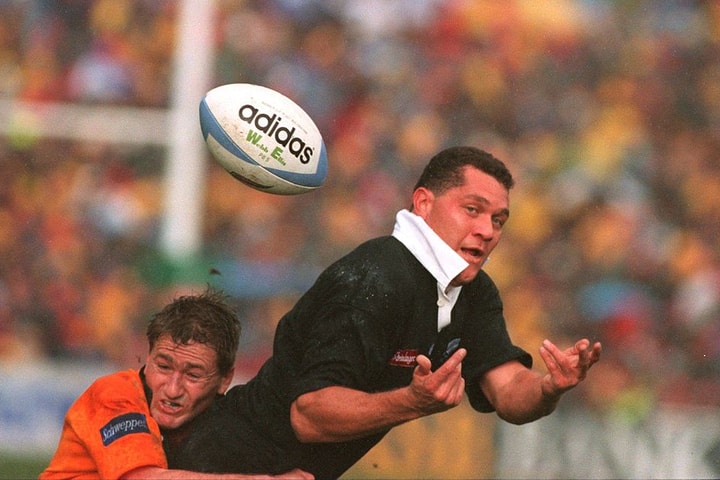It is true the English players were running out of stamina
because of the unusual heat. But from another perspective, it seems
fair to state that an approach Japan Coach Ohnishi had developed,
with key words "Charging in", "Shifting around" and "Continuity"
was successful, and the Japanese side rose to the occasion
harnessing great speed, dexterity and endurance as collective
strength. Japan were resolute in defence, too, with their
relentless low tackles in which the players reach for the ball
carrier's ankles. Their tenacity sapped the opponent's morale.
Roger Uttley, while watching the highlights of the game, makes a
remark on a superb counter attack launched by the home side; "Well
interesting now…how much happens nowadays in modern rugby, and that
was being done back then." He also speaks his mind after viewing
the footage; "…just how physically demanding it was. Physical
condition of the Japanese players who just kept coming all
afternoon. There was no moment when we could relax in the game. We
were always on the edge really. So I count myself lucky that a) I
survived, and b) as a team we managed to come out on the right side
on the day."
The England XV Tour Management had a sense of crisis. Their
confidence that the England XV could surely overpower their
opponents with their sheer size began to waver. They felt the
national pride was at stake. After coming back to Tokyo, the
Management canceled the sightseeing tour. Instead they requested
the JRFU to prepare a ground, despite heavy downpours caused by the
typhoon, for practice in the run-up to the final clash.
September 28 Final Match Day
Before departure from the training camp in the west of Tokyo,
Coach Ohnishi gathered the entire squad together to the meeting
room. He then directed the team to write down on the back of a team
photograph their thoughts on the looming battle. The place had a
solemn atmosphere. No words. They just let the pen flow. Number 8
Yoshihiro Murata, 24, who had been instructed by Ohnishi to defend
the second defensive line at any cost and had made his
international debut, scoring a try in the first 'test' , wrote
down, "One Shot One Kill." After a little while, a band of players
in JRFU blazers and ties, with their indomitable spirit, headed for
the station and boarded the train to downtown Tokyo.
Kick-off was set for 7.00pm. Above and beyond the JRFU's
expectations, fans and supporters began to cluster around the
Prince Chichibu Memorial Ground from as early as midday. Long
queues were seen from the nearest subway station to the gates of
the venue. Well over 25,000 crammed into the Ground that had a
seating capacity of 17,000. As a makeshift solution, the JRFU
urgently made arrangements for lawn seats. However, close to 1,000
fans were barred from entering despite the swift arrangements by
the organizer. Some of the enthusiastic fans tried to watch the
match from adjacent buildings with binoculars to witness history in
the making.
10 Minutes Before Kick-off
Captain Tadayuki Ito recalls,
"The changing room was filled with the strong smell of
Salomethyl ointment rubbed into our body. Some of the players were
banging their upper body against the lockers. I could readily feel
everyone's intense anxiety. We were all under a lot of strain.
After pulling on the pristine jersey, we gathered around
Ohnishi-san. There, I felt myself an unswerving loyalty to him
turned into an unwavering determination."
Ohnishi gently took a glass cup out of his bag and poured water
into it. He then told the starting XV to pass the cup around and
take turns in sipping the water. "Mizu-sakazuki!" everyone thought
to themselves. ("Mizu-sakazuki" refers to a Japanese ritual that
was performed during the war among the people who were destined
never to meet again and literally translates as 'water and a
shallow pottery vessel typically used for drinking sake'.)
When the cup returned back to Ohnishi, he drank up the remaining
water in one gulp and slammed the empty cup against the concrete
floor. He told the team to hold hands with each other, and gave
them a rousing pep talk:
"The rise and fall of future Japanese rugby entirely depend on
the outcome of today's match. Be a creator of a new history of
Japanese rugby! You make it happen! Go and do it!"
The roar of the players echoed around the room. They ran out
onto the hallowed turf, where, under floodlights, capacity audience
was waiting for the final clash with high expectations. The scene
was set.







